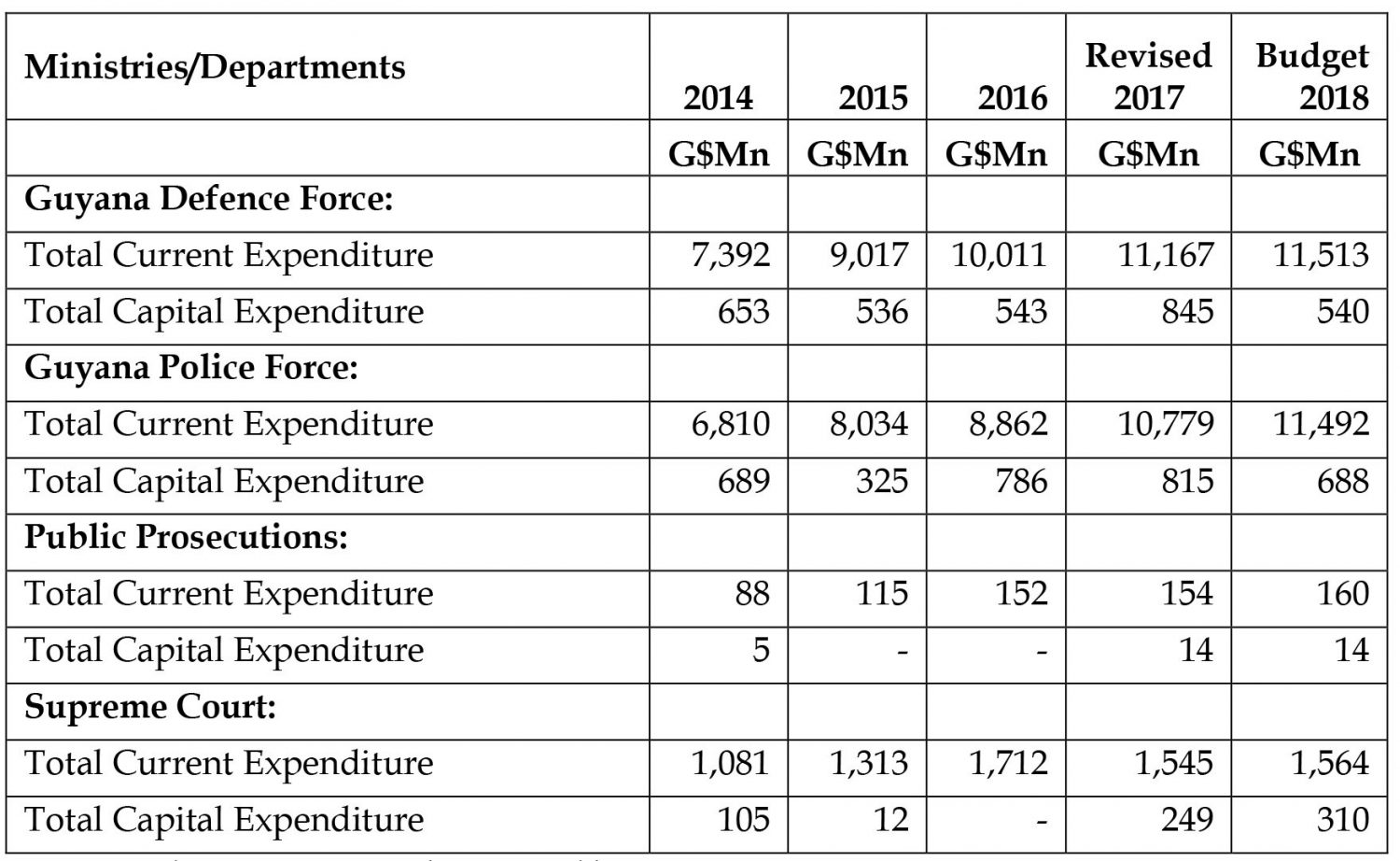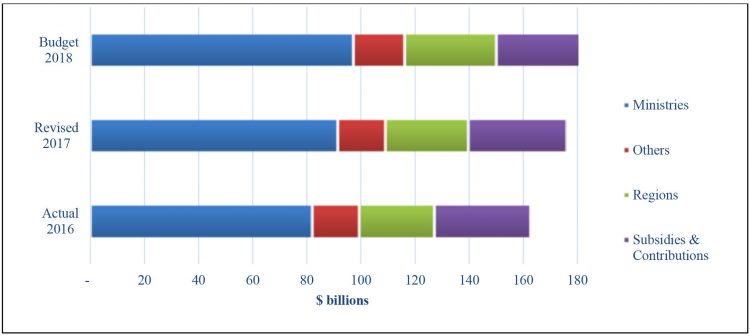Current Non-Interest Expenditure
Expenditure in the National Budget is incurred under a number of categories. These are: statutory payments which are direct charges on the Consolidated Fund, including allocations for constitutional bodies and offices and public debt payments of interest and principal; Ministries; Departments and Regions; and Statutory bodies.
In this section, Focus looks at the current expenditure by the type of agency. The chart below shows the allocations with “Others”, representing Commissions, the judiciary and the Defence Force.
Analysis of expenditure by type of disbursing agency
A disproportionate and the largest percentage of the expenditure is controlled by ministers and the amount continues to grow, a glaring inconsistency with the Constitutional provision that requires devolution of authority to the regions and implies that adequate resources should be allocated.
Note: The tables below include Subsidies and Contributions under the respective Ministry.
Central Government’s non-interest current expenditure (employment costs, statutory expenditure and other charges) for the year is budgeted at $188.4 billion which is 7% more than the revised 2017. The Ministries/ Departments with the most significant allocations and the largest changes between 2017 and 2018 are:
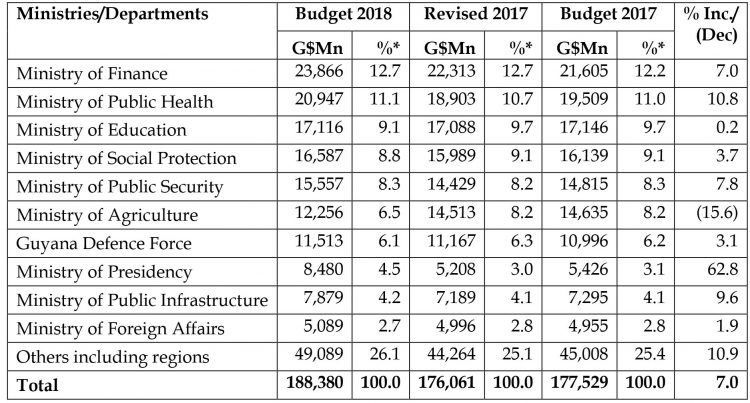
While the Ministry of Finance consistently ranks at or near the top, the expenditure is not all incurred within the Ministry. It includes payments for GRA of $6 billion (2017: $5.2 billion), its tax collecting agency, other subsidies and contributions of $1.5 billion (2017: $1.4 billion), “other employment costs” which includes provisions for public service salary increases of $6.2 billion (2017: $5.7 billion) and pension increases of $3.3 billion (2017: $2.9 billion).
Capital Expenditure
Central Government’s capital expenditure for the year is budgeted at $59.7 billion which is 2.7% above the revised 2017 and 28.79% of total 2018 expenditure. The Ministries/Departments with the most significant capital expenditure allocations are:
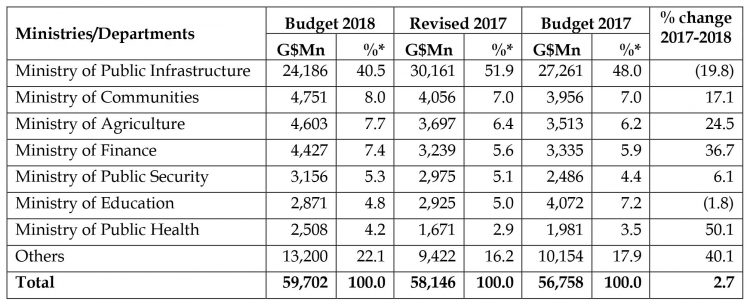
Source: Budget Estimates, Volume 1, Table 10.
The regions with the most significant allocations are:

An analysis of expenditure per person using the 2012 Census as the basis is as follows:
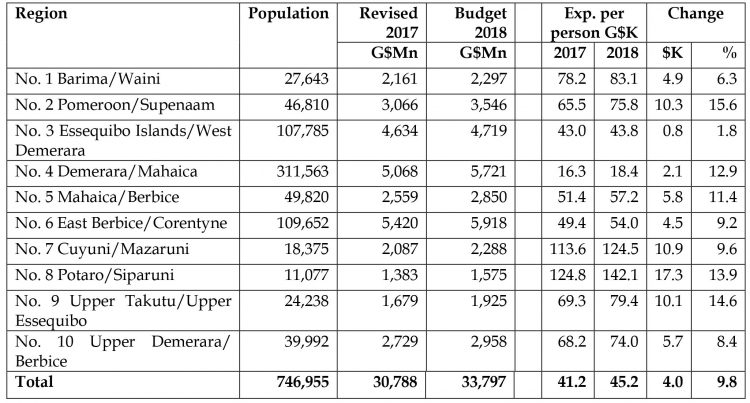
Although Region No. 4 appears to receive the lowest direct allocation per person, agencies such as the Georgetown Public Hospital are located in this region and receive allocations outside of the regional administration.
The funds expended on the principal law enforcement, maintenance and administrative bodies.
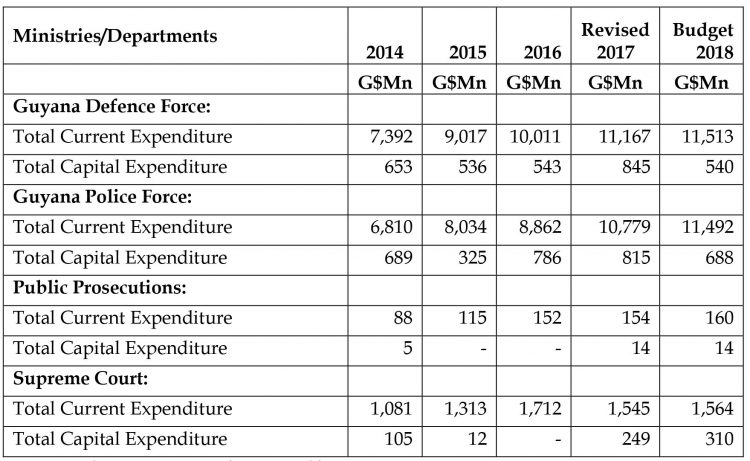
Ram & McRae’s Comments
- Expenditure on the ballooning Ministry of the Presidency continues to climb with a 62.8% increase budgeted for 2018. Subsidies for Culture, Youth and Sport are now shown under the Ministry of the Presidency while the Integrity Commission has been moved from this Ministry to the Office of the Prime Minister.
- The current Parliament has little to show for the $1.5 billion per year that it has cost taxpayers and its paltry legislative results are an absolute disgrace. It appears that there are two constraints to its effectiveness: its inability to have meaningful sessions because of its members’ penchant for overseas travel and the apparent lack of awareness of ministers of their responsibility for the issuance of the regulations that give meaning to legislation.
- The Department of Public Information has been granted $250 million, up from $215 million in the prior year (to the then Government Information Agency).
- Contributions to the Financial Intelligence Unit and the Guyana Securities Council have fallen by 8% and 11% respectively despite announcements in the budget speech for capacity building and institutional strengthening in these agencies and a plan to expand the functions of the Council
- Expenditure on the Statistical Bureau will more than double from $434 million to $900 million while NICIL will receive $200 million, up from $130 million in 2017.
- Ministry of Finance has included a subvention of $400 million in its latest estimates for 2017 to local authorities. We believe this is a provision for a bailout of the Georgetown Mayor and City Council but a supplementary appropriation has not yet been brought to the National Assembly.
- A significant decrease in expenditure through the Ministry of Agriculture reflects Governments reduction of subsidies to the sugar industry – an amount of $6.3 billion has been allocated to Guysuco compared to $9 billion in 2017.
- Linden residents will continue to receive a $2.2 billion contribution towards electricity charges.
- A National Data Management Authority will receive $1.8 billion more than 2017 – no mention was made of this in the speech but it appears that this is a reclassification of amounts previously allocated under Public Telecommunications under the Ministry of Public Telecommunications. Half of this amount in both the current and prior years has been included as “Other goods and services”.
- The State Assets Recovery Agency (SARA) has been granted an allocation of $260 million, up from $90 million in 2017. Separate provision for the Special Organised Crime Unit (SOCU) was not sure and this is expected to be included under the Guyana Police Force, expenditure for which showed significant increases in 2017 and 2018 budgets.
- The total budget for the Police and Army is $24.2 billion, up from $23.6 billion in 2017. Between 2014 and 2018 projected total expenditure on the Army will have risen from $8.0 billion to $12.0 billion, almost as much as is spent on Agriculture and more than is allocated to any Region.
